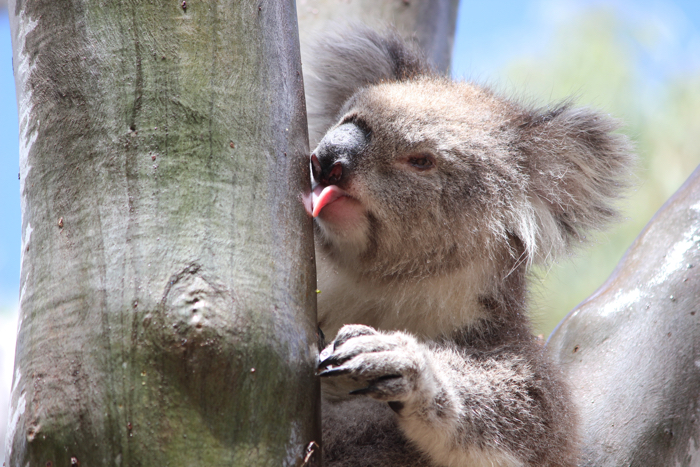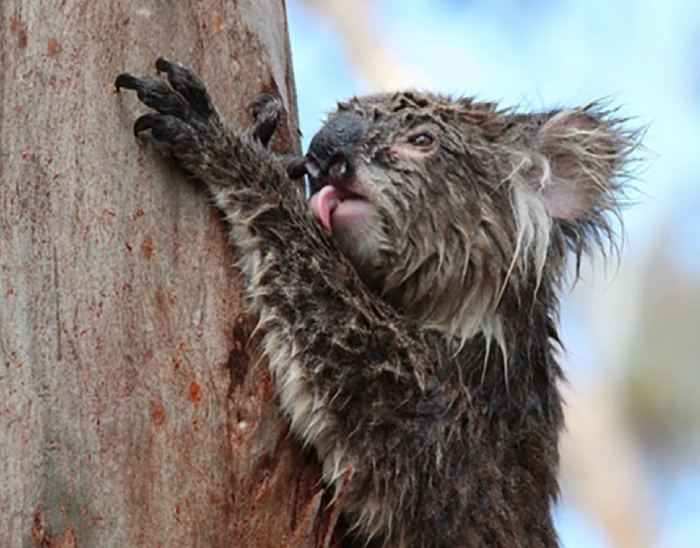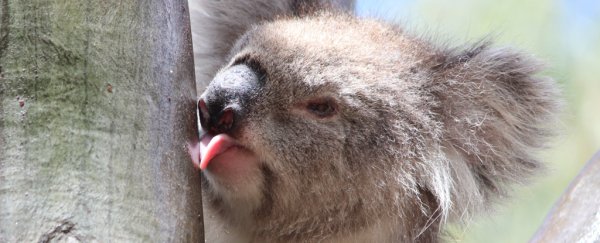It's long been thought that koalas get most of the water they need from the succulent eucalyptus leaves that provide the basis of their diet, but new research reveals we've been missing a vital way these iconic marsupials quench their thirst.
A new study documenting over a decade's worth of observations by researchers and citizen scientists in Australia shows that koalas also routinely drink water by licking the surface of wet tree trunks and branches after rainfall.
"For a long time, we thought koalas didn't need to drink much at all because they gained the majority of the water they need to survive in the gum leaves they feed on," says zoologist Valentina Mella from the University of Sydney.
"This significantly alters our understanding of how koalas gain water in the wild. It is very exciting."
 (Echidna Walkabout and Koala Clancy Foundation)
(Echidna Walkabout and Koala Clancy Foundation)
While koalas have previously been observed drinking free water, both in captivity and during times of heat and hardship stemming from drought and fire, Mella and team say records of such water-drinking are limited to only a handful of incidental observations documented in scientific literature, suggesting we might have underestimated the extent of this natural drinking behaviour.
If that's the case, modern observers may not be the first to miss this. Koalas (Phascolarctos cinereus), are said to take their common name from the indigenous Australian Dharug word 'Gula', meaning 'no water'.
The new observations suggest that name could be a misnomer. In the new study, Mella's team collected 44 observations of free-ranging koalas drinking in trees in You Yangs Regional Park in Victoria, during routine monitoring of their behaviour, plus two more from the Liverpool Plains in New South Wales.
"Koalas were observed licking the water running down the trunk of trees during, or immediately after a rain event," the authors report.
In their paper, the team notes that animal behaviour researchers don't normally conduct observations during heavy rainfall events for reasons of safety – something that might also explain why we haven't noticed this before, since researchers usually seek shelter during storms.
If so, we've been missing out on something happening in plain sight. In the new research, "every time behavioural observations were conducted in the rain, koalas were recorded drinking," the team writes.
"This type of drinking behaviour – licking tree trunks – relies on koalas being able to experience regular rainfall to access free water and indicates that they may suffer serious detrimental effects if lack of rain compromises their ability to access free water," Mella explains.
 (Echidna Walkabout and Koala Clancy Foundation)
(Echidna Walkabout and Koala Clancy Foundation)
"We know koalas use trees for all their main needs, including feeding, sheltering and resting. This study shows that koalas rely on trees also to access free water and highlights the importance of retaining trees for the conservation of the species."
When koalas drink this way, they really go at it. In one observation, a female koala drank "profusely and uninterruptedly" for 15 minutes, with her joey curled up in her lap.
In another sighting, an adult male lapped at a tree continuously for 34 minutes, maintaining a steady pace of about two licks per second. It was still going when the researchers left it to its drinking.
The researchers' observations took place across a range of different kinds of weather conditions, indicating it's not just drought and the intense heat, flame, and ash of bushfire seasons that trigger these bouts of water consumption.
"This suggests koalas were drinking not as a result of heat stress and that this behaviour is likely to represent how koalas naturally access water," Mella says.
"Our observations probably only represent a minority of the drinking that normally takes place in trees during rainfall."

One thing's for sure: the findings, and what they imply about koalas' water-drinking needs, come at an exceptional time in the ongoing survival of this famous Australian animal.
Last year, researchers made headlines when they proclaimed the koala was "functionally extinct" due to steep population declines in recent years. That dire pronouncement went too far, but it also came months before the horror show of the last Australian summer, where thousands of koalas are estimated to have perished in the megablaze conditions that burned out of control for months.
If the koala is to have any hope, knowing as much as we can about their needs will be crucial for the species survival.
"Koalas are expected to continue to incur severe contractions in their distribution as the climate becomes warmer and drier," the researchers write, "so our observations have significant management and conservation consequences for the species, as water supplementation might represent a necessity to maintain some koala populations in this changing climate."
The findings are reported in Ethology.
